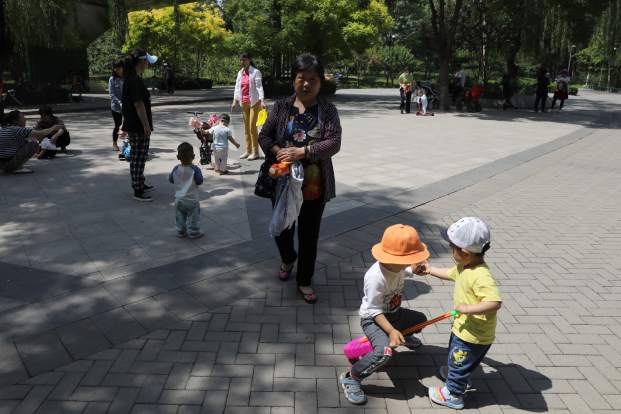China’s population is likely to have fallen in 2023 for a second consecutive year due to a surge in Covid-related deaths after the country abruptly ended strict lockdowns, analysts say.
And a lack of confidence in the country’s economy’s prospects has helped keep birth rates depressed, they say.
Demographers estimate population data on January 17 to show the number of new births in 2023 falling below the 9.56 million in 2022 because long-standing issues such as gender inequality and high childcare costs remained largely unaddressed. China’s birth rate has been declining since 2016.
Further denting appetite for baby-making, youth unemployment hit record highs, wages for many civil servants and white-collar workers fell, and a crisis in the property sector – where more than two thirds of household wealth is stored – intensified.
ALSO SEE: Apple Facing Rough Year in China as Huawei Gains Market Share
The data will add to concerns that the world’s second-largest economy’s growth prospects are diminishing due to fewer workers and consumers, while costs with elderly care and retirement benefits put more strain on indebted local governments.
“The slower-than-expected economic recovery and the uncertainty of the future in China play a bigger role” in fertility than any positive effect coming from lifting Covid curbs, Xiujian Peng, senior research fellow at the Centre of Policy Studies at Victoria University in Melbourne, said.
Demographers expect deaths to have risen sharply, as the Covid-19 virus swept through China’s 1.41 billion population early last year after Beijing unexpectedly removed restrictions in December 2022.
China reported 121,889 total Covid deaths to the World Health Organisation, most of which would have occurred after the curbs were dismantled. The UN body had criticised Beijing for under-reporting deaths, which officials repeatedly denied.
Overwhelmed crematoriums and pressure on doctors not to classify deaths as Covid-related had fuelled suspicion over China’s data transparency.
In a rare move last July, China’s Zhejiang province, home to 5% of the country’s population, reported a 70% surge in cremations in January-March last year. The data has since been taken down.
One study by Seattle-based Fred Hutchinson Cancer Center estimated 1.87 million excess deaths over what would normally be expected from all causes among Chinese older than 30 between December 2022 and January 2023.
University of Michigan demographer Zhou Yun said next week’s data may underreport the population decline to hide the magnitude of the Covid impact and project optimism.
“Population data reporting in China is as much a demographic issue as it is a political event,” she said.
Ratio of elderly citizens rising
The population dip comes as China grapples with the challenge of a rapidly ageing demographic. The number of people older than 60 years is expected to increase from around 280 million currently to over 400 million by 2035 – more than the population of the United States.
Besides low incomes and high job uncertainty, demographers also blame gender discrimination and expectations that women assume the caretaker role in the family as factors discouraging baby-making.
President Xi Jinping said last year that women should tell “good family tradition stories,” adding it was necessary to “actively cultivate a new culture of marriage and childbearing,” which he linked to national development.
Local governments have announced various measures to encourage childbirth, including tax deductions, longer maternity leave and housing subsidies.
One set of data pointing to lower birth rates in 2023 is the 2022 slump in marriage rates to their lowest since 1979. Marriages are seen as a leading indicator for births in China, where most single women cannot access child-raising benefits.
Marriages are expected to have risen year-on-year in 2023, state media reported, as the Covid backlog cleared, but this would not be enough to ease long-term concerns about China’s shrinking and ageing population, demographers said.
China’s fertility rate dropped to a record low of 1.09 in 2022 from 1.3 in 2020, state media reported. It is among the world’s lowest alongside other east Asian economies.
Fuxian Yi, a demographer at the University of Wisconsin-Madison, expects new births at roughly 8 million, which he says would be the lowest since the mid-18th century when China’s total population was below 200 million people.
Yi says this is the ongoing effect of the one-child policy China implemented from 1980 to 2015 as smaller generations tend to have fewer babies. He also blamed economic factors.
Peng from Victoria University estimates fewer than 9 million births, but says a dip below 8 million is “a plausible scenario.”
A December policy paper by the Yuwa Population Research institute urged authorities to “urgently” reverse a decline in newborns through generous family subsidies.
“The most worthwhile investment in China today is children,” it said.
- Reuters with additional editing by Jim Pollard
ALSO SEE:
‘Nearly 2 Million Extra Deaths’ After China Ended Covid Curbs
China Stops Publishing Youth Jobless Data Amid Record Numbers
Weak Demand Pushes China Into Possible Year-Long Deflation
Biden Likens China to ‘Ticking Time Bomb’ Due to Economic Woes
China Parents Paying Jobless Offspring to be Children – Fortune
China’s Graduates Face Worst Job Crisis in Generations – SCMP
























